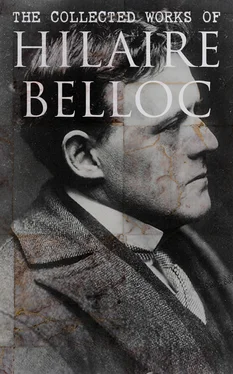Otto maintained his position, hoped against hope that Clerfayt might yet force his way through before nightfall, and was still master of Tourcoing and the surrounding fields when darkness came.
(B) The Third Column under York
Meanwhile York, with his 10,000 half British and half Austro-Hessian, had marched with similar success but against greater obstacles parallel with Otto, and to his left, and had successively taken every point in his advance until he also had reached the goal which had been set before him.
Details of that fine piece of work deserve full mention.
Delayed somewhat by a mist in the dark hours before dawn, York’s command had marched north-westward up the road from Templeuve, where now runs the little tramway reaching the Belgian frontier.
The French troops in front of him, as much as those who had met Otto a mile or two off to the right, and Bussche still further off at Mouscron, were taken aback by the suddenness and the strength of the unexpected blow. They stood at Lannoy. York cannonaded that position, sent certain of the British Light Dragoons round to the left to turn it, and attacked it in front with the Brigade of Guards. The enemy did not stand, and the British forces poured through Lannoy and held it just as Otto in those same hours was pouring into and holding Leers and Wattrelos. Beyond Lannoy, a matter of two miles or so, and still on that same road, was the small town, now swollen to a great industrial city, called Roubaix. The Duke of York left a couple of battalions of his allied troops (Hessians) to hold Lannoy, and with the rest of the column pursued his march.
Roubaix offered far more serious resistance than Lannoy had done. The element of surprise was, of course, no longer present. The French forces were concentrating. The peril they were in of being cut off was by this time thoroughly seized at their headquarters, and the roll of land immediately before Roubaix was entrenched and held by a sufficient force well gunned. A strong resistance was offered to the British advance, but once more the Brigade of Guards broke down that resistance and the place was taken with the bayonet.
York’s next objective, and the goal to which his advance had been ordered, was Mouveaux. Mouveaux is a village standing upon a somewhat higher roll of land rather more than two miles from the centre of Roubaix, in continuation of the direction which York’s advance had hitherto pursued. From Mouveaux the eye could overlook the plain reaching to the Lys and to Wervicq, some seven odd miles away, a plain broken by one or two slight hummocks of which the least inconspicuous holds the village of Linselles. Mouveaux was the point to which Clerfayt was expected to advance from his side. It was on a level with Tourcoing, and lay, as Tourcoing did, precisely upon the line between Courtrai and Lille. To reach Mouveaux, therefore, and not to be content with the capture of Roubaix, was consistent with and necessary to the general plan of the allies. Moreover, as Otto with the second column had taken Tourcoing, it was necessary that the third column should proceed to Mouveaux, unless Otto’s left or southern flank was to remain exposed and in peril. One may say, in general, that until Mouveaux was occupied the chance of joining hands with Clerfayt (supposing that General to have kept to his time-table and to be across the Lys and marching up to meet the columns from the Scheldt) was in peril. Therefore, until one has learnt what was happening to the fourth and the fifth columns, it is difficult to understand why the Duke of York, after the difficult capture of Roubaix, desired to make that point the utmost limit of his advance and for the moment to proceed no further. Without anticipating the story of the fourth and fifth columns, it is enough to say that the Duke of York’s desire not to advance beyond Roubaix was sufficiently excused by the aspect of the country to the west and south upon his left.
Roubaix overlooks from a slight elevation the valley of the Marque. Lest the word “valley” be misleading, let me hasten to add that that stream here flows at the bottom of a very slight and very broad depression. But, at any rate, from Roubaix one overlooks that depression for some miles; one sees five miles distant the fortifications of Lille, and the intervening country is open enough to betray the presence of troops. Indeed, once Roubaix was captured, the English commander could see across those fields, a couple of hours’ march away, the tents of the great French camp at Sainghin under the walls of the fortress.
Now, along that river valley and across those fields there should have been apparent in those mid hours of the day, when the Guards had stormed Roubaix, the great host of the fourth and fifth columns coming up in support of the second and third.
If the time-table had been observed, the Arch-Duke and Kinsky, over 25,000 men, should have been across the Marque before dawn, should have pushed back the French forces outside Lille, and should, long before noon, have been covering those fields between Roubaix and Lille with their advancing squadrons and battalions. There was no sign of them. If, or when, the French body near Lille were free to advance and attack the Duke of York’s left flank, there was no one between to prevent their doing so. That great body of the third and fourth columns, more than half of all the men who were advancing from the Scheldt to meet Clerfayt, had failed to come up to time. That was why the Duke of York desired to push no further than Roubaix, and even to leave only an advance guard to hold that place while he withdrew the bulk of his command to Lannoy.
But his decision was overruled. The Emperor and his staff, who, following up the march of this third column, were now at Templeuve, thought it imperative that Mouveaux should be held. Only thus, in their judgment, could the junction with Clerfayt (who, though late, must surely be now near at hand) be accomplished. And certainly, unless Mouveaux were held, Otto could not hold his advanced position at Tourcoing. The order was therefore sent to York to take Mouveaux. In the disastrous issue that order has naturally come in for sharp blame; but it must be remembered that much of the plan was already successfully accomplished, that Clerfayt was thought to be across the Lys, and that if the French around Courtrai, and hitherward from Courtrai to Tourcoing, were to be cut off, it was imperative to effect the junction with Clerfayt without delay. Had Clerfayt been, as he should have been at that hour in the afternoon of Saturday the 17th, between the Lys and the line Mouveaux-Tourcoing, the order given by the Austrian staff to the Duke of York would not only have been approved by the military opinion of posterity, but any other order would have been thought a proof of indecision and bad judgment.
Upon receiving this order to take Mouveaux, York obeyed. The afternoon was now far advanced, very heavy work had been done, a forward march of nearly six miles had been undertaken, accompanied by continual fighting—latterly, outside Roubaix, of a heavy sort. But if Mouveaux was to be held before nightfall, an immediate attack must be made, and York ordered his men forward.
Mouveaux stands upon one of those very slight crests which barely diversify the flat country in which Roubaix and Tourcoing stand. The summit of that crest is but little more than fifty feet higher than the bottom of the low, broad depression between it and the centre of Roubaix, of which swollen town it is to-day a western suburb. Slight as is the elevation, it does, as I have said, command a view towards the Lys and Wervicq; and the evenness and length of the very gentle slope upon the Roubaix side make it an excellent defensive position.
I have pointed out how the columns of attack as they advanced could not fail to find an increasing resistance. Roubaix had held out more strongly than Lannoy, Mouveaux was to hold out more strongly than Roubaix. The position was palisaded and entrenched. Redoubts had even been hastily thrown up by the French at either end of it, but the weight of the attacking column told. It was again the Guards who were given the task of carrying the trenches at the bayonet, and after a sharp struggle they were successful. The French, as they retired, set fire to the village (which stands upon the very summit of that roll of land), and were charged in their retirement by Abercromby with the English Dragoons. They left three hundred upon the field, and three field-pieces as well. Despite the great superiority of numbers which York’s columns still commanded over the enemy immediately before him, it was a brilliant feat, especially when one considers that it came at the very end of a day that was hot for the season, that had begun before one o’clock in the morning, and that had involved the carrying of three positions, each more stoutly defended than the last, within an advance of over seven miles.
Читать дальше












